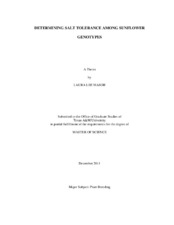| dc.description.abstract | Crop lands around the world are becoming more salt-affected due to natural processes and agricultural practices. Due to this increase of salinization, acquisition of saline tolerant germplasm for breeding purposes is becoming a priority. Although cultivated sunflower is classified as a moderately salt tolerant crop, highly tolerant germplasm may be of value. The goal of this study was to screen Helianthus spp. in order to determine the salt tolerance of different genotypes. To accomplish this goal, a novel method of rapid screening was developed. Screening for tolerance at initial growth stages was accomplished by germinating seeds in varying concentrations of NaCl solution in petri dishes. Radicle lengths were measured as an indicator of tolerance. This method identified genotypes that are more tolerant than others during germination. Greenhouse trials were also conducted to ascertain morphological measurements during vegetative stages. Two field locations were chosen to screen germplasm for tolerance through physiological maturity; College Station, TX with low salt concentrations and Pecos, TX with high concentrations of salt in the soil and water. Vegetative growth measurements showed a significant genotype by environment interaction. Due to insect infestation in both locations, yields could not be accurately measured and thus compared between sites in 2010. Yields between locations in 2011 showed significant differences and identified germplasm more suited for cropping in salt affected soil. Seed oil content was determined with Fourier Transform Near-Infrared Spectroscopy. Seed oil content was not significantly different between locations, but was highly significant between genotypes. These screenings identified genotypes that are more salt tolerant than others. | en |


